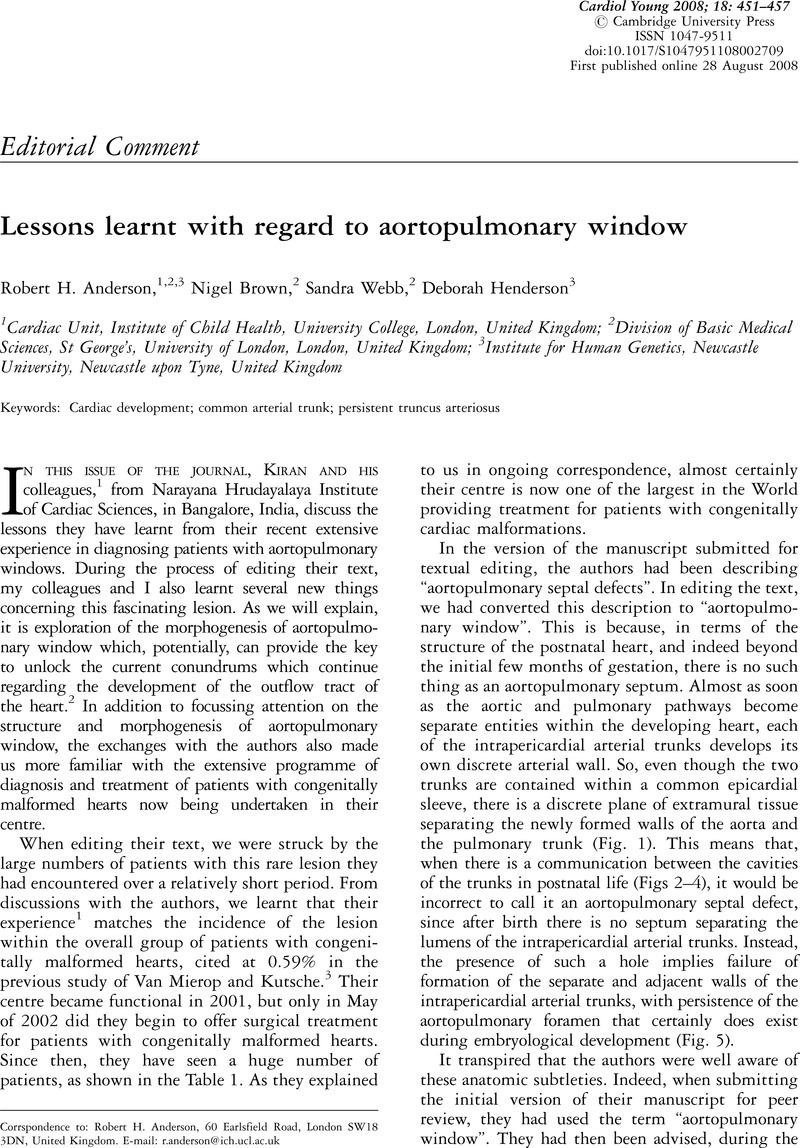Crossref Citations
This article has been cited by the following publications. This list is generated based on data provided by Crossref.
Colon, Michael
Anderson, Robert H.
Weinberg, Paul
Mussatto, Kathleen
Bove, Edward
and
Friedman, Alan H.
2008.
Anatomy, morphogenesis, diagnosis, management, and outcomes for neonates with common arterial trunk.
Cardiology in the Young,
Vol. 18,
Issue. S3,
p.
52.
Anderson, Robert H.
Cook, Andrew
Brown, Nigel A.
Henderson, Deborah J.
Chaudhry, Bill
and
Mohun, Timothy
2010.
Development of the outflow tracts with reference to aortopulmonary windows and aortoventricular tunnels.
Cardiology in the Young,
Vol. 20,
Issue. S3,
p.
92.
Talwar, Sachin
Garg, Pankaj
Kothari, Shyam Sunder
Gulati, Gurpreet Singh
Anderson, Robert H.
and
Airan, Balram
2012.
Aortopulmonary Window With the Absence of Left Pulmonary Artery.
World Journal for Pediatric and Congenital Heart Surgery,
Vol. 3,
Issue. 3,
p.
389.
Chang, Yun Hee
Sung, Si Chan
Kim, Hyungtae
and
Lee, Hyoung Doo
2012.
Anterior Translocation of the Right Pulmonary Artery for Relief of Airway Compression in the Repair of Distal Aortopulmonary Window and Interrupted Aortic Arch.
The Annals of Thoracic Surgery,
Vol. 93,
Issue. 6,
p.
e159.
Miquerol, Lucile
and
Kelly, Robert G.
2013.
Organogenesis of the vertebrate heart.
WIREs Developmental Biology,
Vol. 2,
Issue. 1,
p.
17.
Scansen, Brian A.
Schneider, Matthias
and
Bonagura, John D.
2015.
Sequential segmental classification of feline congenital heart disease.
Journal of Veterinary Cardiology,
Vol. 17,
Issue. ,
p.
S10.
Alsoufi, Bahaaldin
Schlosser, Brian
McCracken, Courtney
Kogon, Brian
Kanter, Kirk
Border, William
and
Sachdeva, Ritu
2016.
Current Outcomes of Surgical Management of Aortopulmonary Window and Associated Cardiac Lesions.
The Annals of Thoracic Surgery,
Vol. 102,
Issue. 2,
p.
608.
Hofbeck, Michael
Deeg, Karl-Heinz
and
Rupprecht, Thomas
2017.
Doppler Echocardiography in Infancy and Childhood.
p.
87.
Courchaine, Katherine
Rykiel, Graham
and
Rugonyi, Sandra
2018.
Influence of blood flow on cardiac development.
Progress in Biophysics and Molecular Biology,
Vol. 137,
Issue. ,
p.
95.
Aurigemma, David
Dixon, Chandler
Tucker, Suzanne
Davis, Christopher
and
Silverman, Norman
2019.
Aortopulmonary window in tetralogy of Fallot with absent conal septum.
Echocardiography,
Vol. 36,
Issue. 2,
p.
411.
Koh, Wonshill
Morell, Evonne
Moguillansky, Diego
Munoz, Ricardo A.
and
Morell, Victor O.
2020.
Critical Care of Children with Heart Disease.
p.
185.
Fuller, Stephanie
and
Anderson, Robert H.
2023.
Pediatric Cardiac Surgery.
p.
409.
Dayton, Jeffrey D.
and
Kourtidou, Soultana
2023.
Pediatric Cardiology.
p.
1.
Dayton, Jeffrey D.
and
Kourtidou, Soultana
2024.
Pediatric Cardiology.
p.
1977.



